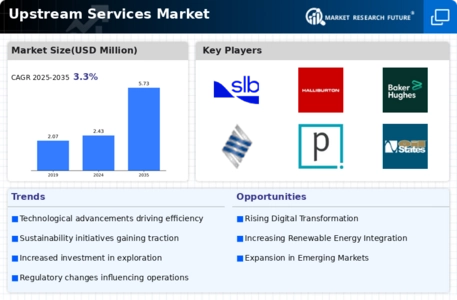Geopolitical Factors
Geopolitical dynamics significantly impact the Global Upstream Services Market Industry. Political stability in oil-rich regions is crucial for uninterrupted exploration and production activities. Fluctuations in oil prices, often influenced by geopolitical tensions, can lead to increased investments in upstream services as companies seek to secure their operations. For example, conflicts in key oil-producing regions can disrupt supply chains, prompting firms to enhance their upstream capabilities. As nations navigate these complexities, the market is expected to adapt, with companies focusing on diversifying their supply sources and investing in risk management strategies to mitigate geopolitical risks.
Increasing Energy Demand
The Global Upstream Services Market Industry is experiencing a notable surge in energy demand, driven by population growth and industrialization. As countries strive to meet their energy needs, investments in upstream services are becoming increasingly critical. In 2024, the market is projected to reach 2.43 USD Billion, reflecting the urgency for exploration and production services. This demand is expected to escalate further, with projections indicating a market size of 5.73 USD Billion by 2035. The compound annual growth rate (CAGR) of 8.1% from 2025 to 2035 highlights the sustained interest in upstream services as nations prioritize energy security and sustainability.
Market Growth Projections
The Global Upstream Services Market Industry is projected to experience substantial growth over the coming years. With a market size of 2.43 USD Billion in 2024, the industry is expected to expand significantly, reaching 5.73 USD Billion by 2035. This growth trajectory, characterized by a compound annual growth rate (CAGR) of 8.1% from 2025 to 2035, underscores the increasing demand for upstream services. The upward trend is indicative of the sector's resilience and adaptability in response to evolving energy needs and technological advancements. As the market evolves, stakeholders are likely to seek innovative solutions to capitalize on emerging opportunities.
Technological Advancements
Technological innovations play a pivotal role in shaping the Global Upstream Services Market Industry. The integration of advanced technologies such as artificial intelligence, big data analytics, and automation enhances operational efficiency and reduces costs. For instance, predictive maintenance technologies can significantly minimize downtime in drilling operations. As these technologies evolve, they enable companies to optimize resource extraction and improve safety measures. The ongoing digital transformation within the sector suggests that firms investing in these advancements are likely to gain a competitive edge. Consequently, the market is poised for growth as these technologies become more prevalent in upstream operations.
Investment in Renewable Energy Integration
The Global Upstream Services Market Industry is witnessing a gradual shift towards integrating renewable energy sources into traditional upstream operations. As the global energy landscape evolves, companies are exploring hybrid models that combine fossil fuel extraction with renewable energy initiatives. This transition is driven by the need for energy diversification and sustainability. Investments in technologies that facilitate this integration are likely to reshape the market. Firms that successfully navigate this transition may not only enhance their operational resilience but also align with global sustainability goals, positioning themselves favorably in a changing energy market.
Regulatory Frameworks and Environmental Policies
The Global Upstream Services Market Industry is increasingly influenced by evolving regulatory frameworks and environmental policies. Governments worldwide are implementing stricter regulations to mitigate environmental impacts associated with oil and gas exploration and production. This shift necessitates the adoption of sustainable practices and technologies within the upstream sector. Companies that proactively align with these regulations may find themselves better positioned in the market. The emphasis on environmental sustainability is likely to drive innovation in upstream services, fostering the development of cleaner extraction methods and reducing the carbon footprint of operations.


















Leave a Comment